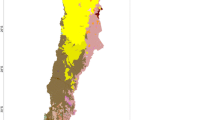Summary
A global classification system of natural terrestrial ecosystems (including systematic notation), based on the climate zones of Walter, is presented. The basic units of the system are the ecological units biome and biogeocoene. The zonobiomes, which are climate zones corresponding to the largest vegetation units, are subdivided into subzonobiomes and these into individual biomes. The biomes are thus natural, geographical units within the climate zones. They are in turn subdivided into individual biogeocoenes and their constituent synusiae. In addition, the coordinate concepts of pedobiome and orobiome are introduced. These are distinguished from the zonobiomes as follows:
1. the pedobiomes by extreme edaphic conditions which cause azonal vegetation.
2. the orobiomes, as mountain ranges, by their vertical climate zonation and the altitudinal belts of vegetation.
These relationships are explained, and two subseries of pedo-and oro-subunits are established. Transitional zones (zono-ecotones) between individual zonobiomes are also distinguished. The classification system is summarized in a schematic, and a world map of zonobiomes and zono-ecotones is included. More details are presented in Walter (1976).
Zusammenfassung
Ein globales Gliederungssystem der natürlichen terrestrischen Ökosysteme (einschließlich systematischen Bezeichnungen) wird in Beziehung zu den Walter'schen Klimazonen gesetzt. Grundeinheiten des Systems sind die ökologischen Einheiten Biom und Biogeozön. Die Zonobiome werden unterteilt in Subzonobiome und diese in Biome. Die Zonobiome sind Klimazonen und entsprechen den größten Vegetationseinheiten. Die Biome sind natürliche, geographische Einheiten innerhalb der Klimazonen. Sie werden bis zu einzelnen Biogeozönen und ihren Synusien (Teilsytemen) unterteilt. Parallel dazu werden die Begriffe Pedobiom und Orobiom eingeführt. Diese heben sich aus den Zonobiomen heraus: die Pedobiomen durch extreme Böden, die eine azonale Vegetation bedingen, die Orobiome als Gebirge durch die vertikale Klimagliederung und die Höhenstufen der Vegetation. Diese Beziehungen werden erklärt, und zwei Nebenreihen der Pedo- bzw. Orobiom-Untereinheiten werden aufgestellt. Zwischen den einzelnen Zonobiomen werden Übergangszonen (Zonoökotone) unterschieden. Das Gliederungssytem wird bereits in einem Schema zusammengefaßt, und eine Weltkarte der Zonobiome und Zonoökotone wird beigefügt. Ausführlich werden alle diese Fragen bei WALTER (1976) behandelt.
Similar content being viewed by others
References
Duvigneaud, P. 1974. La synthèse écologique. Doin, Paris, 296 pp.
Ellenberg, H. 1963. Vegetation Mitteleuropas mit den Alpen. (volume IV of Einführung in die Phytologie. H. Walter). Ulmer, Stuttgart, 943 pp.
Ellenberg, H. (ed.) 1971. Integrated Experimental Ecology. Ecological Studies. Vol. 2. New York-Heidelberg-Berlin.
Gams, H. 1918. dePrinzipienfragen der Vegetationsforschung. Naturf. Gesell. Zürich, Vierteljahrschr., 63: 293.
Goryshina, T.K. (ed.) 1974. Biological Productivity and its Factors in an Oak Forest of the Forest-Steppe. (Russian) Scientific Papers of the University of Leningrad. Vol. 6.
Sukachev, V.N. & N.V. Dylis. 1964. Foundations of Forest Biogeocoenology. (In Russian). Moscow.
Walter, H. 1949. Standortslehre (analytisch-ökologische Geobotanik.) (Vol. III, part 1 of ‘Einführung in die Phytologie’; Second edition: 1962. Ulmer, Stuttgart, 566 pp.
Walter, H. 1968. Die Vegetation der Erde. Vol. II. Fischer Jena-Stuttgart, 1001 pp.
Walter, H. 1971. Ecology of Tropical and Subtropical Vegetation. Oliver & Boyd, Edinburgh, 539 pp.
Walter, H. 1973. Die Vegetation der Erde. Vol. 1 (3rd ed.) Fischer Jena-Stuttgart, 743 pp.
Walter, H. 1973a. Vegetation of the earth. Springer London-New York, 237 pp. (English translation of ‘Vegetationszonen und Klima’, UTB 14, Stuttgart)
Walter, H. 1974. Vegetation Osteuropas, Nord- und Zentralasiens. (volume VII of the vegetation monographs of the individual regions). Fischer, Stuttgart, 452 pp.
Walter, H. 1975a. Besonderheiten des Stoffkreislaufes einiger terrestrischer Ökosysteme. Flora 164: 169–183.
Walter, H. 1975a. Die Ökologischen Beziehungen zwischen Steppenpflanzen und alpinen Elementen. Flora 164: 339–46.
Walter, H. 1976. Die Ökologischen Systeme der Kontinente (Biogeosphäre); Prinzipien ihrer Gliederung mit Beispielen. Fischer, Stuttgart, 130 pp.
Walter, H. & H. Lieth. 1960–67. Klimadiagramm-Weltatlas (in three deliveries). Fischer Jena.
Walter, H., E. Harnickell & D. Mueller-Dombois 1975. Klimadiagramm-Karten der einzelnen Kontinente und ökologische Klimagliederung der Erde (with 9 maps). Fischer, Stuttgart, (also in English edition ‘Climate-diagram Maps’ through Springer-Verlag, New York-Heidelberg-Berlin).
Author information
Authors and Affiliations
Rights and permissions
About this article
Cite this article
Walter, H., Box, E. Global classification of natural terrestrial ecosystems. Plant Ecol 32, 75–81 (1976). https://doi.org/10.1007/BF02111901
Issue Date:
DOI: https://doi.org/10.1007/BF02111901




